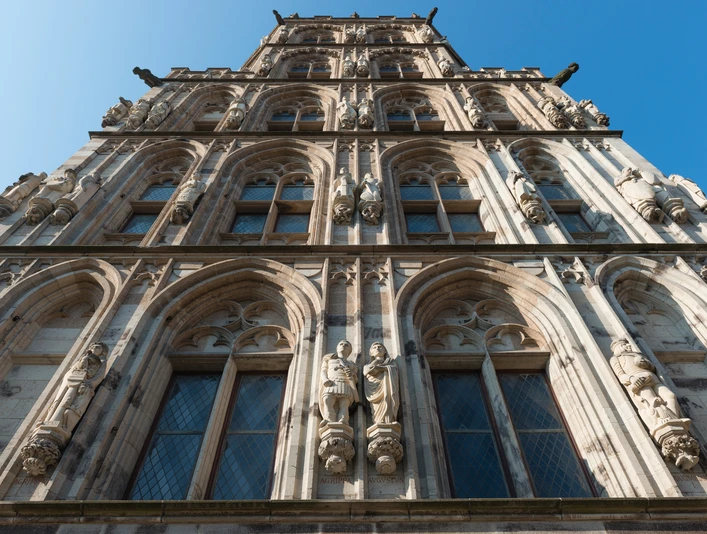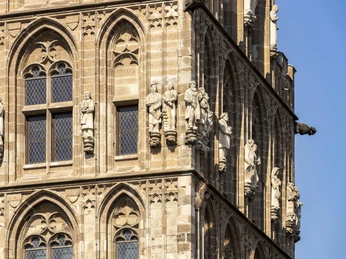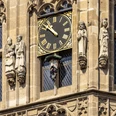- Photos & Map
How would you like to arrive?
- Call
- Details
- Useful Information
- Nearby
The tower clock strikes - and every hour on the hour, someone sticks out their tongue at us from the historic Cologne City Hall: a wild-looking man with wide eyes, black hair, and a floppy hat. Platzjabbeck, that's the name of the somewhat curiously named wooden head on the City Hall tower below the tower clock. And it is not the only sculpture here to bring a smile or provoke thought.
Beyond the sculptures, the historic City Hall is extremely worth seeing because, due to its architectural testimonies, it is considered the oldest City Hall in Germany and thus merits a stop on your Cologne city center tour.
In total, the carillon features a repertoire of 24 melodies: folk songs, Cologne classics, as well as compositions by Offenbach and Stockhausen. You might also be lucky enough to attend one of the annual concerts when carillonneurs from home and abroad are invited.
During the rebuilding, the original figure decoration was initially omitted but was added in 1986. Today, the City Hall tower’s facade displays 124 sculptures: figures up to the end of the Middle Ages such as Charlemagne, notable personalities of the city like Farina, Wallraf, or Adenauer, as well as patron saints and holy figures like Ursula, Gereon, and Peter.
Beyond the sculptures, the historic City Hall is extremely worth seeing because, due to its architectural testimonies, it is considered the oldest City Hall in Germany and thus merits a stop on your Cologne city center tour.
Germany’s Oldest City Hall
Overall, the construction history spans 800 years. The first documented mention dates back to the years 1135-1152. Over the centuries, additions were continuously made to the core building. The oldest part still preserved today was constructed in 1330. Between 1407-1414, the City Hall tower was added, the Renaissance loggia between 1569-1573, and the Spanish building in 1660/61. Today, bridal couples can exchange vows in the historic ambiance of the tower cellar. Other wedding rooms are located in the City Hall's Spanish building.Carillon: 9 AM, 12 PM, 3 PM, and 6 PM
Between 9 AM and 6 PM every day, you have the opportunity to listen to a carillon from the City Hall tower’s 48 bronze bells. They were donated in 1958 by Cologne’s guilds as successors to the medieval guilds after being destroyed during World War II. Konrad Adenauer also donated one bell.In total, the carillon features a repertoire of 24 melodies: folk songs, Cologne classics, as well as compositions by Offenbach and Stockhausen. You might also be lucky enough to attend one of the annual concerts when carillonneurs from home and abroad are invited.
City Hall Tower with 124 Sculptures
Standing 61 meters tall with five stories, the City Hall tower was intended for storing documents, privileges, and money letters. Numerous stone figures adorned the tower across four stories. Unfortunately, they mostly succumbed to the weather over the following centuries, compounded by the bombings in World War II which nearly completely destroyed the historic City Hall and tower. Only a few figures on the south side survived.During the rebuilding, the original figure decoration was initially omitted but was added in 1986. Today, the City Hall tower’s facade displays 124 sculptures: figures up to the end of the Middle Ages such as Charlemagne, notable personalities of the city like Farina, Wallraf, or Adenauer, as well as patron saints and holy figures like Ursula, Gereon, and Peter.
Sculpture Ensemble Per Story
Different sculptural groups adorn each story of the City Hall: rulers and ruler-like persons populate the ground floor. On floors 1 through 3, you'll see characters significant to Cologne's city history. At the very top, on the 4th floor, patron saints watch over Cologne’s citizens, as is appropriate. Let’s take a quick look at the floors …Ground Floor: Rulers and Ruler-like Persons
On the ground floor, you can see sculptures of Marcus Vipsanius Agrippa, who established a settlement in what is now Cologne’s area, and Agrippina the Younger, through whom Oppidum Ubiorum received Roman city rights and the name Colonia Claudia Ara Agrippinensium, which eventually became Cologne. Other important characters include the sculpture of Plektrudis, who once dedicated a private church at the site of St. Mary in the Capitol, or Theophanu, who advanced the construction of St. Pantaleon. From the steps at the City Hall tower, you can view the figures.Upper Floors 1-3: Key Players in Cologne’s City History
No sculpture ensemble would be complete without Reinald von Dassel, who once brought the relics of the Three Wise Men to Cologne and boosted pilgrimages to the Cologne Cathedral. Another significant figure is certainly artist Stefan Lochner, whose famous panel painting "Mother of God in the Rose Garden," or "Cologne's Mona Lisa," is housed today in the Wallraf-Richartz Museum & Foundation Corboud. Johann Maria Farina is also among Cologne’s influential figures as the founder of the world’s oldest perfume factory, viewable in the Farina House, and is represented along with many other city personalities like Wallraf, Mevissen, Adenauer, Ostermann, Haubrich, and many more across these three floors.Fourth Floor: Cologne Heaven
Patron saints like Peter, the Three Wise Men, Gereon, Saint Ursula, Severin, Albertus Magnus – to name a few – watch over Cologne from the top floor.The Platzjabbeck: Cheeky Every Hour
The Platzjabbeck has adorned the City Hall tower since the 15th century. Its gesture is unmistakably seen as an insult or at least a rejection. However, this naturally applies less to you and more historically indicates the rejection of the patricians by the guilds, pointing to a newfound self-confidence in the bourgeoisie. The mechanism that allows the Platzjabbeck to stick out its tongue like clockwork each hour on the hour was only "retrofitted" in 1913.Spicy, Obscene – and a Common Medieval Motif
The historic City Hall also gained online fame due to a special stone figure that caused a social media stir: the statuette that shows its bare behind and holds its genitalia in its mouth – a popular medieval motif against prevailing moral or order concepts dictated by the authorities. If you want to discover the figure yourself, it hangs under Archbishop Konrad von Hochstaden on the first floor of the City Hall tower.Useful Information
Eligibility
Bad Weather Offer
Suitable for any weather
for Groups
for Class
for individual guests
Openings
Dayoff: Saturday, Sunday, Closed all holidays
Payment methods
Entrance Free
Parking facilities
The walk from the stop Rathaus (Tram: 5) to the Historic City Hall takes about 2 minutes.
General information
Parking Available
Bus stop available
Our recommendations
Nearby



